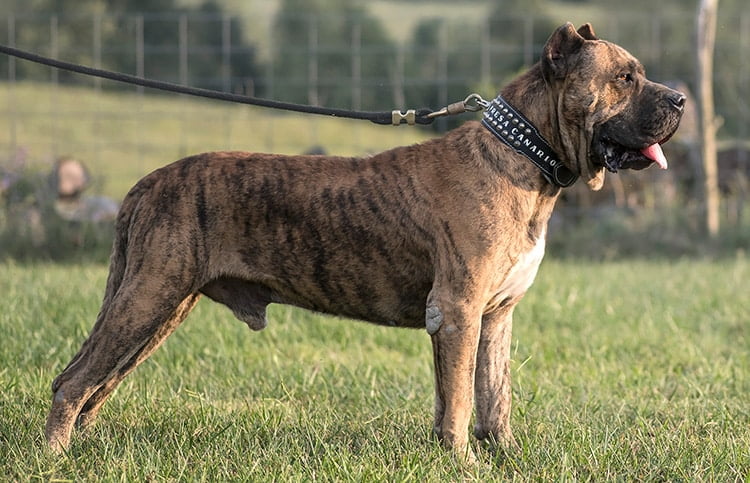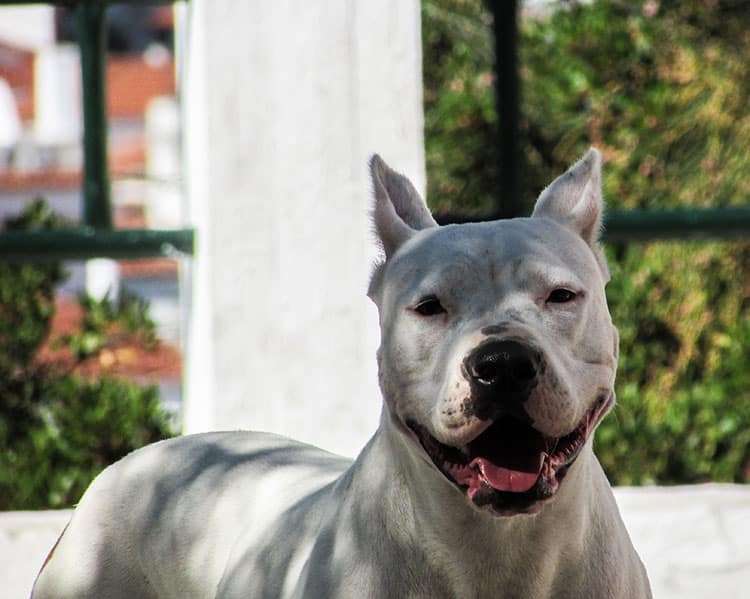There are raising concerns should Pit Bulls be banned throughout the country, or just securely contained by the owner on its property, with an invisible fence, for example.
Even though many wouldn’t agree, and the opposite opinions are on the rise, it’s beyond our control.
If you’re a passionate pit bull lover and finally decided to get one, don’t get frustrated.
There are several dog breeds with the same bold aesthetic but not affected by the ban or regulations themselves.
Today I’m sharing a list of dogs that look like a Pit Bull but aren’t with you.
Whether you’re trying to duck regulations or just trying to find a “type” of Pit Bulls without the high-energy terrier temperament, there’s something here for everyone.
American Bulldog

The American Bulldog is often mistaken for a Pit Bull, and it’s easy to see why. They’re large, powerful dogs with a surprisingly broad head and some massive jaws. They’re generally a bit more muscular than most Pit Bulls, with a bit shorter legs.
If you go by the book, you’ll find that American Bulldogs’ weight varies between 60 to 120 pounds, and that they grow to be between 20 to 28 inches.
The truth is, this breed is known to exceed these proportions easily, so don’t worry if your American Bulldog becomes a bit bigger than expected!
Why American Bulldog?
- They look confident & cute at the same time
- They are easy to groom
- They are immensely loyal
American Bulldogs are actually a Mastiff breed, so they have a different temperament from the usual boisterous, high-energy attitude you see in Pit Bulls.
They still require a lot of exercise, though, and they’re a working dog. While they look imposing, they’re actually quite friendly with people as a general rule and probably shouldn’t be relied upon as a guard dog.
They will get high-strung if not exercised enough, but if you can make that commitment, they’ll be at home in almost any lodgings.
Be prepared to get a DNA test to prove your dog isn’t a Pit Bull if you live in a jurisdiction where they require special insurance, however, as they’re similar enough that less educated people will often mistake them for a particularly large pit.
American Bulldogs can have certain health complications, but luckily, these aren’t inherent of the entire breed.
American Bulldog – Key Similarities & Differences with Pit Bulls
- Temperament: While both of the breeds are active, strong, and healthy, American Bulldogs have a better reputation. They are considered a suitable breed for a family. Pit Bulls are loved for their loyalty, and they are often groomed as guarding dogs.
- Life expectancy: Bulldogs have a higher life expectancy as they have fewer genetic predispositions for illnesses than Pit Bulls.
- Size: Through the lens of a person who isn’t a dog lover, these breeds seem precisely the same. Their essential difference lies in their appearance, as American Bullies tend to be much larger than Pit Bulls.
- Coat color: Another key difference is the color of their coat, with American Bulldogs often being white with patches that can be red, brown, or black. Pit Bulls can be of virtually any color.
- Training: Both of the breeds are known for both their intelligence and stubbornness.
Presa Canario

The Presa Canario looks like a large Pit Bull, but the truth is that they’re actually closer to the common perception of Pit Bulls than the pits themselves. They’re very large, aggressive dogs that require training in order not to be a complete handful.
And just like enjoying these Spanish islands from rugged black beaches to almost desert panoramas, owning a Presa Canario is an intense and demanding yet pleasurable journey.
While not easy for a novice owner to take care of, these imposing dogs make fantastic companions when raised correctly. They can be quite docile and excellent family dogs, although strangers will likely want to take care around them regardless of how well trained the dog is.
Why Presa Canario?
- They are fearful and loyal; thus very protective of their owners
- You get a well-prepared and eager companion for any physical activity, from jogging in the park to hiking
- They love to socialize
They’ll also require a lot of exercise to keep their energy levels from getting too high. They can reach weights of over one hundred pounds as well, so they’re actually much larger than most Pit Bulls can ever hope to be.
Remember that they were originally bred as guard dogs. Pit Bulls, despite the common perception of them, weren’t, and if the only “guard dog” you’ve owned has been a pit, you’re in for a possibly unwelcome surprise when you introduce a real guard dog to your home.
For the experienced dog owner with a strong hand, the Presa Canario is highly recommended but, due to their size and personality, novice dog owners or those who often let dogs get their own way should steer clear of these massive, powerful dogs.
Presa Canario – Key Similarities & Differences with Pit Bulls
- Temperament: Whereas Pit Bulls are loveable and adorable with children, Presa Canario comes off as territorial and somewhat aggressive. They require a firm hand and steady guiding to be as accepting as your normal Pittie is.
- Life expectancy: They are somewhat similar in this area, as the Presa Canario has a life expectancy of 10 to 13 years.
- Size: Here lies their main difference. Presa Canario dogs are much larger and heavier than Pit Bulls are.
- Coat color: In regards to the purity of the breed, Presa Canario can only be of some of the following colors, the most common being: fawn, red brindle, brown brindle, reverse brindle, and Verdino brindle.
- Training: The Presa Canario makes for a loyal companion, but they are very hard to master and train. Their training must begin when they are just puppies!
American Pit Bull Terrier

Despite the bad reputation, the American Pit Bull Terrier is the best dog in the world (if you can handle it). While they do look like Pit Bulls, one can mostly tell them apart by paying attention to their faces. American Bull Terriers have triangular eyes and erect ears, and a slightly narrower head, but not many people will notice this.
The American Pit Bull Terrier will forever be remembered by most in the US as a purebred dog that was initially bred as a skilled competitor for sports involving dogs. They’re also a great dog to go with if you want something of similar appearance and mannerisms to a Pit Bull, but somewhat more guard-oriented.
They’re squat and muscular dogs, with an unyielding will that may require some heavy-handed training at times, but mostly they’re just large terriers in personality.
Why American Pit Bull Terrier?
- They are affectionate, but also protective
- They are in for taking a walk (and pretty much anything) 24/7
- They are super-playful and agile
Coming with the terrier territory is the fact that they are high-energy and have a prey drive second to none. Don’t let the calm face fool you; if your American Pit Bull Terrier gets off the leash near a smaller animal, there’s probably going to be trouble.
They’re not recommended for complete novice dog owners, but if you have a little bit of experience and the time to exercise them correctly, they can be an absolute joy to own. They tend to be destructive when they’re not given enough attention, which means that they’re not a dog to keep if you work long hours.
What they are, however, is an iconic dog with a great personality for those who have the time for them.
Key Similarities & Differences with Pit Bulls
- Temperament: It may surprise some of you, but terriers actually can have more aggressive tendencies than a Pit.
- Life expectancy: On average, American Pit Bull Terriers do not have many health issues, and life expectancy is a bit higher than Pit’s (11-15 years).
- Size: The size of these two breeds is the most significant similarity between the two. That’s why they look so similar!
- Coat color: Another similarity is that coats of both breeds come in many colors and varieties. from black to white and fawn.
- Training: American Pit Bull terriers can be a bit more stubborn to train, but they, nevertheless, are very playful and energetic, so the only thing they require is patience!
Dogo Argentino

If you can’t have a Pit Bull, and want an impressive, muscular dog, this is the breed for you. They’re much bigger than Pit Bulls, despite how closely they resemble them, and not quite as hyper. Despite this, they’ll still require a ton of exercise and are best suited to athletic owners who can both handle a large dog and are willing to take it out on enough adventures to keep its impressive musculature intact.
The Dogo Argentino is a massive, white, Mastiff-type breed that was bred almost exclusively to produce guard dogs initially, and many breeders have maintained that line of thought in choosing which dogs to breed.
Why Dogo Argentino?
- You’ll get a fierce guardian of you & your family
- They don’t require a lot of grooming
- You’ll simply grow together with the Dogo Argentino (both mentally and physically). Better prepare for some exercise!
One thing to keep in mind, should you choose one of these impressive canines as your companion, is that they generally aren’t safe around other animals. This includes common household pets like cats, although if you get them as a puppy and train them properly, they probably won’t go after them.
If you’re an experienced dog owner looking for a constant companion, acquiring a Dogo Argentino as a puppy is a great option. Bear in mind that they’re not particularly well suited to pack mentality, and keeping one with another dog of the same sex is a recipe for disaster.
Dogo Argentino – Key Similarities & Differences with Pit Bulls
- Temperament: The thundering bark usually signals the brittle temperament of the Dogo Argentino, which can be tamed, but only if you are equally strong-willed.
- Life expectancy: The lifespan is one of the similarities between the two (10-14 years).
- Size: The Dogo Argentino can grow much bigger than the Pit Bull, and weighs 95-100 pounds on average.
- Coat color: With a few exceptions, depending on the Dogo Argentino’s pedigree, they are almost exclusively white.
- Training: Prepare for even more vigorous and demanding exercise if you want to train an Dogo Argentino . But when you succeed in doing so, prepare to feel superior and proud of yourself and your pet!
Bullmastiff

The Bullmastiff is an iconic breed in its own right, although some less educated individuals might mistake it for a Pit Bull. The first thing you’ll notice upon introduction to one is that they are huge. Like nearly all mastiffs, they’ve been bred as guard dogs for a long time, and it’s so ingrained in Bullmastiff that it’s pretty rare they’ll need any training in that area.
They undergo an exciting transformation as they get older; as puppies they are extraordinarily rambunctious and curious.
They’ll engage in the usual puppy antics and can cause quite a bit of trouble, but upon maturation, they’re dignified dogs that don’t require a lot of exercise.
Like most of the more ursine dogs in the world, there’s a sad fact of owning one: they have short lifespans and are prone to health problems in their old age. They also tend to drool, fart, and generally aren’t the cleanest dogs around, but it can all be worth it for the loyalty and demeanor they possess as adults.
Why Bullmastif?
- They are remarkably intelligent
- They form a reliable and loving bond with the owner
- You will get a companion with keen guarding skills
Despite the superficial resemblance to Pit Bulls, they’re amazingly different and one of the oldest breeds of dogs. Highly intelligent and also quite stubborn, they might present a challenge on occasion. The owner must be able to rise to this challenge and keep their pet in line, which can pose a unique challenge with such a large dog.
If you’re up for the challenge, however, the experience of bonding with a Bullmastiff for its lifespan isn’t something you’ll ever forget.
Bullmastif – Key Similarities & Differences with Pit Bulls
- Temperament: Owning a puppy Bullmastiff and an adult Bullmastiff is an entirely different experiment temperament-wise. The former is very lively and aggressive, similar to a Pit when young, whereas the latter is quiet and mild-mannered. Keep in mind that they also can be very sensitive!
- Life expectancy: Sadly, older Bullmastiffs are prone to health problems, and their lifespan is shorter than Pit Bull’s (8-10 years).
- Size: The typical Bullmastiff is larger than the Pit Bull.
- Coat color: As mentioned, Pit Bulls’ coats can appear in almost any color, whereas Bullmastiffs can be fawn or brindle.
- Training: This breed is very intuitive, meaning that training will be less demanding than with Pit Bulls.
Boxer

Boxers are commonly mistaken for Pit Bulls by a lot of people. Boxers typically have a more muscular build, a broader head, and a distinctive pushed-in nose compared to Pit Bulls. Pit Bulls often have a more athletic appearance, with a wider range of coat colors and patterns, and a head that is wider at the cheeks and narrows towards the muzzle.
They’re fantastic family dogs, but they’ll require a lot of exercise and training them as a puppy is absolutely essential to ending up with a well-mannered dog.
Boxers vary widely in their personal temperament, and each will require their own training and exercise plan to ensure that you end up with the best dog possible.
Why Boxer?
- They are gentle and more cautious than your standard guard dog
- They love children (and vice versa; children love them)
- The Boxer’s coat is easy to maintain
Unfortunately, Boxers often have a short life span and some health problems later in life, making them an often short-lived companion.
The beneficial side of this, though, is that they’re not a “one person” dog, and they’ll be great companions to family and friends alike while they’re around.
They’re playful, loving dogs and almost universally beloved for a good reason. If you’re looking for a dog more likely to lick than they are to bite a stranger, you may want to get a look into getting yourself a Boxer.
Boxer – Key Similarities & Differences with Pit Bulls
- Temperament: Both of the breeds are friendly, playful, and energetic.
- Life expectancy: Boxers tend to have a slightly shorter lifespan than Pit Bulls due to heart and breathing issues they are prone to, but taking your Boxer regularly to the vet can prolong its life!
- Size: Both of these breeds vary in size, from medium (30-40 pounds) to large (70-80 pounds).
- Coat color: Boxer’s coat can be either fawn or brindle, and purebred boxers have a black muzzle.
- Training: Boxer, the same as Pit Bull, requires a reasonable amount of time for training to transform its restless energy into playfulness and guarding.
Ambullneo Mastiff

Ambullneo Mastiff is like a gentle giant, really big and hefty, with a wide, heavy head and those droopy cheeks that give them a distinctive, kind of noble look. Now, a Pit Bull, they’re more like your athletic types, a bit sleeker and muscular, with a unique head shape that’s broad but sort of tapers down towards the nose, and they have this vibrant range of coat colors that really stand out.
If you want a breed close to Pit Bull for guarding your property and your children while being a cuddly goof with family, Ambullneo is for you.
Perhaps the least known out of today’s Pit bull’s twins, the Ambullneo Mastiff was purposefully bred to create the ultimate guard dog. They have an incredible amount of agility for a dog of their size and protective temperament that’s almost unmatched.
Why Ambullneo Mastiff?
- They are the best guardians
- They love to be trained
- They are sure to reciprocate each and every bit of love you have for them
They’re one of the most recently created breeds, and the science behind it is quite fascinating. Three different types of European mastiffs and three different kinds of bulldogs were bred together so as to intentionally create the Ambullneo.
Despite their seeming toughness, these dogs need someone assertive but not overly harsh as they can be quite sensitive to their owner’s emotions. Quite a surprising turn of events considering the largest males of this breed come in at around 150 lbs.
Due to their unique personality, some care has to be taken in raising an Ambullneo Mastiff in order to ensure they aren’t a danger to strangers. They bond quickly with the whole family and will become quite protective of them.
Owing to their singular lineage and purposeful breeding, these fantastic dogs do almost everything that Pitbulls are famed for. Protection, companionship, and more are all built-in features of the Ambullneo Mastiff, and they make great dogs for anyone with the room for them.
Key Similarities & Differences with Pit Bulls
- Temperament: Highly intelligent, the Ambullneo Mastiff is instinctively even more protective and assertive than the Pit Bull. It is also less stubborn than the Pit Bull.
- Life expectancy: Similar (about 10 to 14 years for both).
- Size: Ambullneo Mastiff is the largest breed on today’s list, considering that they can weigh as much as 155 pounds. Their muscular and broad built and bones account for this.
- Coat color: The prototype is brown, but you can find Ambullneo Mastiffs’ coat in a wide range of colors, just like Pit’s.
- Training: Although both breeds are not too difficult to train, the Ambullneo Mastiff is more sensitive, and therefore they will sense any anger and harshness in your voice. So, make sure to treat your Ambullneo Mastiff pet with sensibility (which doesn’t mean there shouldn’t be any assertiveness)!
Cane Corso

The final breed of today’s list, commonly mistaken for a Pit Bull by some, is the Cane Corso, also known as the Italian Mastiff. So, when you look at a Cane Corso, you’re seeing this imposing figure, really solid and powerful, with a broad chest and a majestic, square-shaped head, kind of like a stoic guardian. Then, switch over to a Pit Bull – they’re more on the athletic side, not as bulky as the Corso, with a distinctive head that’s wide at the cheeks but narrows down towards the nose, and they often come in a variety of snazzy coat colors.
As you can guess from its nickname, it belongs to the Mastiff breed, though it is less stocky than other breeds of this kind. Instead, when you see a Cane Corso, the first attributes that come to mind are “impressive” and “muscular”.
What else connects the two is the misconception associated with them, that we mentioned earlier – that they are aggressive and dangerous dogs. It’s high time that a guard dog reputation substituted the undeserved one of a fighter because that’s what these breeds (especially the Cane Corso) are in their essence.
I hope to solve this matter once and for all: the Cane Corso (and some other breeds from my list, which I have indicated) will be an excellent guard dog. Therefore, they’ll be loyal to you and your loved ones, protect your property from intruders, and, overall, be active and alert to specific events.
Why Cane Corso?
- They won’t let you down, both as a friend or as a guardian
- It is easy to teach them anything
- They are not prone to allergies or excessive shedding
Because of their size and almost constant weight gain, these dogs require an experienced owner. When it comes to their training, however, even a complete novice would easily succeed, as these belong to the most intelligent breeds in the world.
So far, you’ve learned that owning the Cane Corso means having a loyal friend, protector, and a bright learner. The final thing we want to mention is that they are not that playful (they won’t be too eager to bring you a ball over and over again), but will engage in games that provide a mental simulation.
Cane Corso – Key Similarities & Differences with Pit Bulls
- Temperament: As noted, both breeds are not fighters, or aggressive, though a Cane Corso will be an excellent watchdog. They are also sensitive and form strong bonds with their favorite humans.
- Life expectancy: The Cane Corso is not notably prone to any health issues, and its lifespan is similar to that of Pit’s (10-14 years).
- Size: The typical Cane Corso weighs more and is larger than a Pit Bull.
- Coat color: The two basic types of coat color of a Cane Corso are black and fawn.
- Training: Training the Cane Corso must be the most pleasurable activity in the world for dog lovers – they are excellent learners and have the disposition (both mental and physical) for anything.
Conclusion
It’s important to remember that just because a dog looks like a Pit Bull, they aren’t necessarily of the same temperament or size. I hope that you enjoyed this list and have given you some idea of what you’re looking for in the next breed of dog you choose to be your companion. Do you prefer more playful, goofy breeds like the Boxer and American Bulldog?
They are more similar to Pit Bulls in temperament in addition to appearance. On the other hand, do you want your dog to have a natural instinct to protect you? Guard dog breeds, like the Ambullneo Mastiff, or Dogo Argentino, are brave and will do anything for you. No matter whether you belong to the first or the second group, the axiom is: you’ll receive double the amount of loyalty, devotion, and love that you offer to a dog that looks like a Pitbull.
Did you like my list? Have some other suggestions for dogs that look like a Pitbull? Leave me a comment below!



1 thought on “8 Dogs That Look Like Pit Bulls But Aren’t”
Comments are closed.